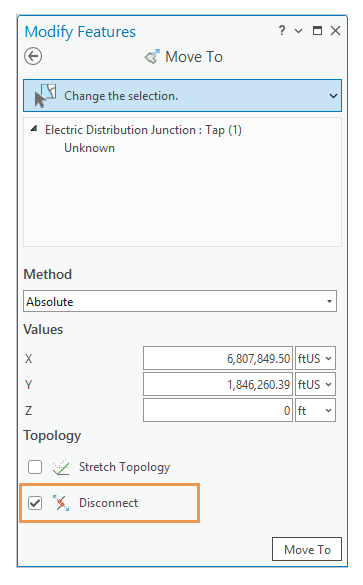When you create or modify features that participate in a utility network, snapping, editing tools, and editing templates apply the rules and associations defined for the network.
The following sections summarize how editing tools work when you edit a utility network. To learn more about connectivity rules and associations, see the following topics:
For a basic workflow to get started, see Edit a utility network
Junction and edge connections
When you place a network feature on a network linear feature segment or cross it with another linear network feature, the polyline is modified based on the junction and edge connectivity rules.
Junction and edge connectivity rules are based on geometric coincidence and control the types of junction assets you can connect to specific edge assets. How a polyline is modified when you make a midspan connection is listed in the following table:
| Editing scenario | Midspan connection permitted | Midspan connection not permitted |
|---|---|---|
Point feature on a polyline feature | A vertex is added to the coincident polyline. | The features are created and not connected. |
Polyline feature crossing a polyline feature | A vertex is added at each intersection and where an endpoint touches the polyline. | The features are created and not connected. |
Nonspatial objects
Nonspatial junction and edge objects are used to model physical components contained inside network features, such as strands inside a fiber cable or conductors inside an underground duct. You can also use them as container objects to contain other nested containers, features, and objects.
Nonspatial objects are stored in stand-alone tables and connected to network features using connectivity, containment, or structural associations.
Feature templates
In Template Properties, the Containment tab is available when the source utility network feature layer participates in a containment association. You can add a containment template to include associated nonspatial objects with each feature the template creates.
The steps are the same as adding a table template on the Relationship side tab if it is available.
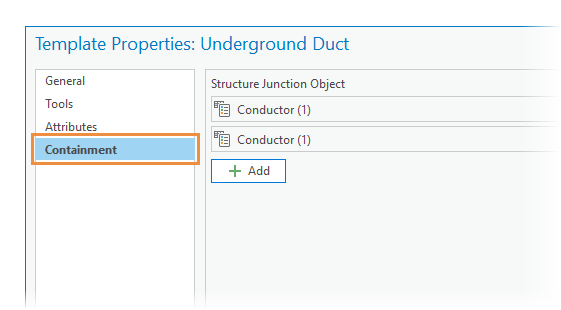
Tip:
Add a containment template to a feature template to streamline a workflow that routinely uses the Attributes pane to add nonspatial objects.
Group and preset templates
Group templates can be configured to generate associations between the features they create when they contain a primary template that creates utility network features. Group template associations are limited to group features only and do not extend to the contents of preset templates assigned to the group.
Preset templates generate associations that were defined when the preset template was authored, independent of any group settings. This is true when you use them as component templates in a group template or as stand-alone templates.
For example, a group template with a primary template for a medium-voltage line and a feature template for a medium-voltage attachment as the snapping device can be configured to generate associations using these features.
If the group template in this example also contains a preset template for a transformer bank, the transformer bank components are placed in a map with the associations defined for them when the preset template was authored.
Snapping
If you turn on snapping and enable snap agents to add or move a network feature, the snap settings automatically change to settings that conform to junction and edge connectivity rules. You can turn snapping off, but you cannot change the layers or features to which you are snapping.
Additionally, the snap chip can be turned on for workflows that need to create network features or edit vertices that must maintain contiguity with specific coincident features such as a power line that must be snapped to either a source or a load terminal.
Tip:
When you create features, press T to view the snappable elements of a feature with respect to the connectivity rules.
To view connectivity rules, right-click the network in the Contents pane, click Properties  , and click the Network Properties tab.
, and click the Network Properties tab. 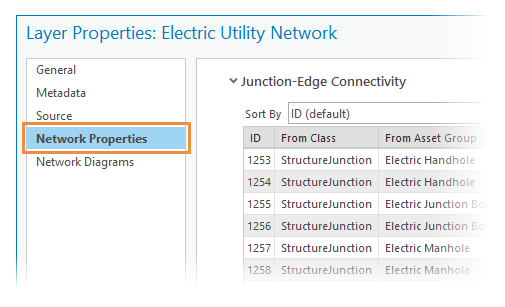
View and edit network attributes
To view and edit utility network attributes in the Attributes pane, select the feature and expand the selection in the tree view. Associations appear below the selected feature or object and report the total number of associated subfeatures or subobjects.
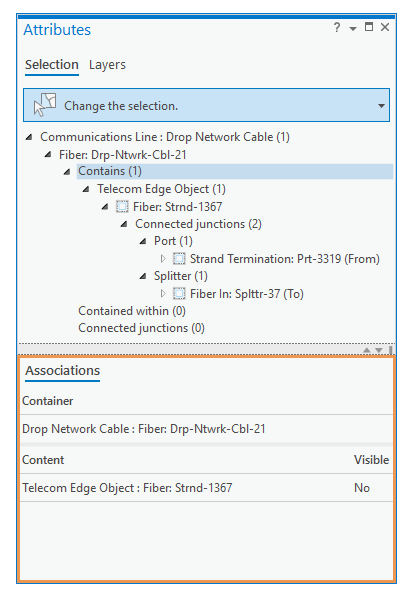
| Editing scenario | Workflow | Command or tool |
|---|---|---|
View From/To network information. | In the tree view, click a junction or edge object. | The Associations tab. |
Add nonspatial objects to an existing container object. | In the tree view, right-click the container. | Add New To Container |
Remove a nonspatial object from a container feature. | In the tree view, right-click the nonspatial object. | Remove Association |
Selections
Editing tools filter selections based on the type of edits the tool performs. To avoid unexpected results when selecting nonspatial objects, for example, in a utility network attribute table, deactivate the current editing tool before running a command.
If an editing tool is filtering the current selection, a notification appears briefly in the current view with the name of the editing tool. To restore the selection to its unfiltered state, deactivate the current tool by pressing the Esc key or clicking the back arrow in the Modify Features pane.
To select associated data in the Attributes pane  , right-click a layer or an individual network feature in the pane's selection tree view, click Select Associated Data
, right-click a layer or an individual network feature in the pane's selection tree view, click Select Associated Data  , and click the corresponding command.
, and click the corresponding command.
- Right-click the feature or object to select associated data for the specific network feature.
- Right-click the layer to perform a bulk selection of associated data for all selected network features in the layer
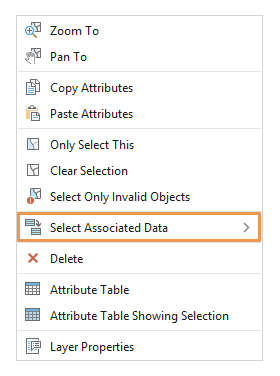
Editing tools
Utility networks use network topology to maintain connectivity among network features and allow you to trace a network, identify connected features, determine flow characteristics, and perform other analytic operations. Network topology does not participate in map topology.
Editing tools and commands described in the following table recognize network topology and include additional functionality for working with utility and trace networks:
| Tool or command | Description |
|---|---|
Stretch Topology | Preserve the general shape of a feature when moving an edge or a vertex by scaling the relative lengths of all feature segments. This editing mode is available with editing tools that modify the location or geometry of features connected to a utility network. On the toolbar for the active editing tool, click the Stretch Topology button |
Disconnect | Disconnect moved features from the network topology. This command is available with editing tools that modify the location or geometry of features connected to a utility network. On the toolbar for the active editing tool, click the Disconnect button |
Move a network feature and coincident features as well as features associated as container objects and structural attachments. This tool is available in the Modify Features pane. If midspan connections are permitted, features that share a coincident endpoint or vertex move with the selected feature, and linear features are stretched so that the visible feature topology remains contiguous. To prevent connected assets from moving, enable Disconnect | |
Move features to a specified coordinate location or by an offset distance or offset direction and distance. This tool is available in the Modify Features pane.
| |
Extend an existing linear feature. By default, network features connected to endpoints move to the new endpoint. This tool is available in the Modify Features pane. To prevent connected assets from moving, enable Disconnect | |
Edit vertices and other network features sharing the same x,y,z location and display a rubber band line that stretches dynamically as the vertex is moved. This tool is available in the Modify Features pane. To prevent connected assets from moving, enable Disconnect | |
Replace the geometry of a selected feature with geometry you sketch. The original feature attributes are preserved. This tool is available in the Modify Features pane. To prevent connected assets from moving, enable Disconnect | |
Split a utility network line feature. The resulting features are connected with a system junction feature at the location of the split. This tool is available in the Modify Features pane. Asset types constrained by attribute domains are determined by the domain split policy defined for the utility network. For example, container contents and associated attribute assignments are maintained based on the containment split policy defined for structure line feature classes. |
 .
.






